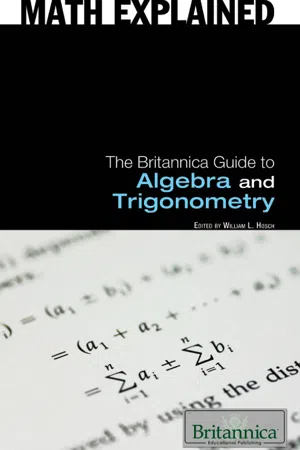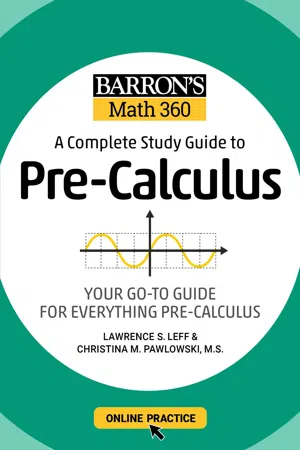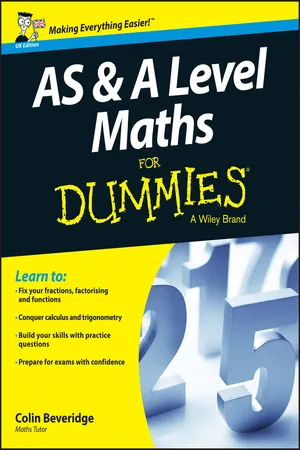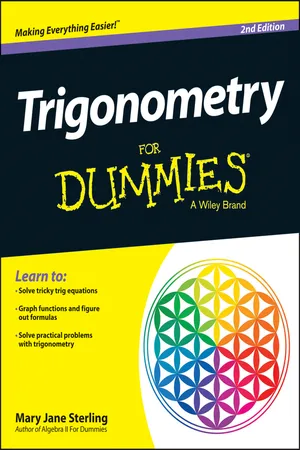Mathematics
Triangle trigonometry
Triangle trigonometry is a branch of mathematics that deals with the relationships between the angles and sides of triangles. It primarily focuses on the trigonometric functions sine, cosine, and tangent, which are used to solve for unknown angles or sides in right-angled triangles. These functions are fundamental in various fields such as physics, engineering, and navigation.
Written by Perlego with AI-assistance
Related key terms
11 Key excerpts on "Triangle trigonometry"
- H. Davies, H.G. Davies, G.A. Hicks(Authors)
- 2014(Publication Date)
- Routledge(Publisher)
Chapter 3Trigonometry
3.1 Introduction
Trigonometry is the branch of Mathematics that deals with the relationships between the sides and the angles of a triangle. Provided that a minimum of
are known about any triangle, the other unknown sides or angles can be calculated using trigonometrical methods.(i) 3 sides, (ii) 2 sides and 1 angle or (iii) 1 side and 2 angles Trigonometry is based on the trigonometrical ratios of sine, cosine and tangent, which are the ratios between the sides of a right-angled triangle. The values of these ratios depend upon the size of the angles, and do not depend on the size of the triangle.3.2 Trigonometric ratios
In Fig. 3.1 sides are given names with respect to the angle θ. The side opposite the right-angle (90°) is called the hypotenuse. The other two sides are named according to their position relative to the angle. The ratios are defined asFor a known angle the values of these ratios can be obtained from an electronic calculator. For example sin 40°=0.6428 can be obtained by entering 40 and pressing the sin key.Fig. 3.1Example 3.1 Find the lengths of the unknown sides in the steel bracket ABC shown in Fig 3.2 .Fig. 3.2Using with θ = 60° andMultiply both sides by 21.4:Using again with θ = 60° and h = 21.4cmExample 3.2 Fig 3.3 shows a voltage diagram for an electronic circuit. Calculate the phase angle ϕ between the two voltages.Fig. 3.3Note: ϕ = cos-1 0.5965 means that ϕ is an angle which has a cos of 0.5965. The value of ϕ can be obtained from the calculator by entering 0.5965 and pressing thecos−1key. cos-1 is the inverse of the cosine (see Section 3.15 ).3.3 Theorem of Pythagoras
This is an important theorem and is a useful alternative method of finding the third side of a right-angled triangle when the other two sides are known. In the right-angled triangle in Fig 3.4 the sides are labelled a, b, c according to the angles that they are opposite.Fig. 3.4- eBook - ePub
- Britannica Educational Publishing, William Hosch(Authors)
- 2010(Publication Date)
- Britannica Educational Publishing(Publisher)
RIGONOMETRYT rigonometry is the branch of mathematics concerned with specific functions of angles and their application to calculations. There are six functions of an angle commonly used in trigonometry. Their names and abbreviations are sine (sin), cosine (cos), tangent (tan), cotangent (cot), secant (sec), and cosecant (csc).Trigonometry developed from a need to compute angles and distances in such fields as astronomy, map making, surveying, and artillery range finding. Problems involving angles and distances in one plane are covered in plane trigonometry. Applications to similar problems in more than one plane of three-dimensional space are considered in spherical trigonometry.HISTORY OF TRIGONOMETRY
CLASSICAL TRIGONOMETRYThe word “trigonometry” comes from the Greek words trigonon (“triangle”) and metron (“to measure”). Until about the 16th century, trigonometry was chiefly concerned with computing the numerical values of the missing parts of a triangle (or any shape that can be dissected into triangles) when the values of other parts were given. For example, if the lengths of two sides of a triangle and the measure of the enclosed angle are known, the third side and the two remaining angles can be calculated. Such calculations distinguish trigonometry from geometry, which mainly investigates qualitative relations. Of course, this distinction is not always absolute: the Pythagorean theorem, for example, is a statement about the lengths of the three sides in a right triangle and is thus quantitative in nature. Still, in its original form, trigonometry was by and large an offspring of geometry. It was not until the 16th century that the two became separate branches of mathematics.ANCIENT EGYPT AND THE MEDITERRANEAN WORLDSeveral ancient civilizations—in particular, the Egyptian, Babylonian, Hindu, and Chinese—possessed a considerable knowledge of practical geometry, including some concepts that were a prelude to trigonometry. The Rhind papyrus, an Egyptian collection of 84 problems in arithmetic, algebra, and geometry dating from about 1800 BCE, contains five problems dealing with the seked . A close analysis of the text, with its accompanying figures, reveals that this word means the slope of an incline—essential knowledge for huge construction projects such as the pyramids. For example, problem 56 asks: “If a pyramid is 250 cubits high and the side of its base is 360 cubits long, what is its seked - eBook - ePub
- (Author)
- 2008(Publication Date)
- Trade Paper Press(Publisher)
Trigonometry solves problems relating to plane and spherical triangles. Its principles are based on the fixed proportions of sides for a particular angle in a right-angled triangle, the simplest of which are known as the sine, cosine, and tangent (so-called trigonometrical ratios). Trigonometry is of practical importance in navigation, surveying, and simple harmonic motion in physics.trigonometry At its simplest level, trigonometry deals with the relationships between the sides and angles of triangles. Unknown angles or lengths are calculated by using trigonometrical ratios such as sine, cosine, and tangent.Using trigonometry, it is possible to calculate the lengths of the sides and the sizes of the angles of a right-angled triangle as long as one angle and the length of one side are known, or the lengths of two sides. The longest side, which is always opposite to the right angle, is called the hypotenuse . The other sides are named depending on their position relating to the angle that is to be found or used: the side opposite this angle is always termed opposite and that adjacent is the adjacent . So the following trigonometrical ratios are used:sine
The sine is the function of an angle in a right-angled triangle which is defined as the ratio of the length of the side opposite the angle to the length of the hypotenuse (the longest side). It is usually shortened to sin .sine The sine is a function of an angle in a right-angled triangle found by dividing the length of the side opposite the angle by the length of the hypotenuse (the longest side). Sine (usually abbreviated sin) is one of the fundamental trigonometric ratios.Various properties in physics vary sinusoidally; that is, they can be represented diagrammatically by a sine wave (a graph obtained by plotting values of angles against the values of their sines). Examples include simple harmonic motion, such as the way alternating current (AC) electricity varies with time.sine (left) The sine of an angle; (right) constructing a sine wave. The sine of an angle is a function used in the mathematical study of the triangle. If the sine of angle β is known, then the hypotenuse can be found given the length of the opposite side, or the opposite side can be found from the hypotenuse. Within a circle of unit radius (left), the height P1 ,A1 equals the sine of angle P1 0A1 - Lawrence S. Leff, Christina Pawlowski-Polanish(Authors)
- 2021(Publication Date)
- Barrons Educational Services(Publisher)
STUDY UNIT IIITRIGONOMETRIC ANALYSIS
Passage contains an image
9 TRIGONOMETRYWHAT YOU WILL LEARN
Trigonometry means “measurement of triangles.” The study of trigonometry arose from the ancient need to understand the relationships between the sides and angles of triangles. With the development of calculus, trigonometry progressed from the study of ratios within right triangles to trigonometric functions that could be used to better represent the circular and repeating patterns of behavior that characterize a wide range of physical phenomena in the real world.This chapter progresses from considering acute angles in right triangles to a more general view of angles as rotations about the origin in the coordinate plane. By fixing the vertex of such an angle at the origin and keeping one side of the angle aligned with the positive x-axis, we can give meaning to trigonometric functions of angles greater than 90° and less than 0°.LESSONS IN CHAPTER 9•Lesson 9-1: Degree and Radian Measures•Lesson 9-2: Right-Triangle trigonometry•Lesson 9-3: The General Angle•Lesson 9-4: Working with Trigonometric Functions•Lesson 9-5: Trigonometric Functions of Special AnglesLesson 9-1: Degree and Radian MeasuresKEY IDEAS
Angle measures can be expressed in units of degrees or in real-number units called radians. Degrees are based on fractional parts of a circular revolution. Radian measure compares the length of an arc that a central angle of a circle cuts off to the radius of the circle. The Greek letter θ (theta) is commonly used to represent an angle of unknown measure.MEASURING ANGLES IN DEGREES AND MINUTES
One degree, denoted as 1°, is of one complete revolution about a fixed point.Each of the 60 equal parts of a degree is called a minute- eBook - ePub
Flash 3D
Animation, Interactivity, and Games
- Jim Ver Hague, Chris Jackson(Authors)
- 2012(Publication Date)
- Routledge(Publisher)
5Math Primer:
Trigonometry 101Many designers’ eyes glaze over and they throw up their hands at the mere mention of trigonometry. Typically one hears exasperated expressions such as, “I can’t do math,” or “trig is too hard,” or “it’s all so abstract.” If you are one of those people, then we have some good news for you. You won’t have to get involved with a lot of math, because ActionScript is going to take care of that for you. Once you get your feet wet, you’ll find that you keep using much of the same stuff over and over. And rather than being abstract, drawing a rough sketch of what you need or want usually leads you to the solution.This chapter is broken down into the basic concepts that you will need, with some examples that demonstrate how to use those concepts. Following is what we will be covering: • What is trigonometry? • Coordinate systems • Angles • The Pythagorean theorem • The distance between two points • Trig functions • Circular motion and elliptical motion • Sine and cosine waves • Inverse trig functionsWhat Is Trigonometry?
Well, what exactly is trigonometry anyway that it should instill such fear in the hearts and minds of so many? Admittedly, it’s a rather imposing word. Let’s take a look at it and break the word apart.Now that’s more like it. Trigonometry is all about trigons, or shapes with three sides. Most of our closest friends like to refer to these shapes as triangles. Trig (let’s shorten the word so it doesn’t sound so imposing) has to do with the study of triangles and the relationship of their sides and angles. Since all triangles have only three sides and three angles, how bad can it be? Not bad, honestly.It’s true there are a lot of different types of triangles in this world. Figure 5.1 - eBook - ePub
Military schools and courses of instruction in the science and art of war,
in France, Prussia, Austria, Russia, Sweden, Switzerland, Sardinia, England, and the United States. Drawn from recent official reports and documents. Revised Edition
- (Author)
- 2013(Publication Date)
- Perlego(Publisher)
Resolution of right-angled triangles.—Of the case in which the hypothenuse and a side nearly equal to it are given. Knowing a side and two angles of any triangle, to find the other parts, and also the surface of the triangle.Knowing two sides a and b of a triangle and the included angle C, to find the other parts and also the surface of the triangle.—The tang.½(A - B) may be determined; or tang.A and tang.B directly.Knowing the three sides a, b, c, to find the angles and the surface of the triangle.—Employment of the formula which gives tang.½A.Application to surveying for plans.Measurement of bases with rods. Measurement of angles.—Description and use of the circle.—Use of the telescope to render the line of sight more precise.—Division of the circle.—Verniers. Measurement and calculation of a system of triangles.—Reduction of angles to the centres of stations. How to connect the secondary points to the principal system.—Use of the plane table and of the compass. 2. SPHERICAL TRIGONOMETRY.Fundamental relations (cos.a = cos.b cos.c + sin.b sin.c cos.A) between the sides and the angles of a spherical triangle.To deduce thence the relations sin.A : sin.B = sin.a : sin.b; cot.a sin.b - cot.A sin.C = cos.b cos.C, and by the consideration of the supplementary triangle cos.A = -cos.B cos.C + sin.B sin.C cos.a.Right-angled triangles.—Formulas cos.a = cos.b cos.c; sin.b = sin.a sin.B; tang.c = tang.a cos.B, and tang.b = sin.c tang.B.In a right-angled triangle the three sides are less than 90°, or else two of the sides are greater than 90°, and the third is less. An angle and the side opposite to it are both less than 90°, or both greater.Resolution of any triangles whatever:1o Having given their three sides a, b, c, or their three angles A, B, C.—Formulas tang.½a and tang.1/2A, calculable by logarithms:2o Having given two sides and the included angle, or two angles and the included side.—Formulas of Delambre:3o - Boris Pritsker(Author)
- 2023(Publication Date)
- Chapman and Hall/CRC(Publisher)
6 Trigonometrical ExplorationsDOI: 10.1201/9781003359500-6Mathematics compares the most diverse phenomena and discovers the secret analogies that unite them.Joseph FourierTrigonometry is encountered in the most diverse problems of algebra, geometry, and calculus. It is a powerful and universal tool in getting links among math disciplines. There are numerous connections between them, expressed by trigonometric identities (you can find such identities in the appendix).In many cases trigonometry allows us to get appealing and efficient solutions compared to applications of pure geometrical or algebraic techniques. We will start with trigonometry “servicing” geometrical problems. PROBLEM 6.1. Of all the triangles with two sides of the given lengths, find the one with the greatest area.SOLUTION.There is no need even to make a diagram to solve this problem, as soon as we applied trigonometry. The area of a triangle can be determined by the formulaPROBLEM 6.2.S =, where a and b are the lengths of two sides, and γ is the angle between them. We know that1 2∙ a ∙ b ∙sin γfor any γ . Hence, the maximum area of a triangle will be attained forsin γ≤ 1, i.e., whensin γ= 1γ = 90 °, and it is. So, we conclude that of all the triangles with two sides of the given lengths the right triangle has the greatest area.S=m a x1 2∙ a ∙ bIn a right triangle, the hypotenuse is c and one of its acute-angle bisectors is. Find the legs.c 33SOLUTION.In the right triangle ABC (One of the possible approaches to this problem is applying algebraic techniques setting up a system of equations. Let’s see where it would get us.∠ A C B = 90 °), we haveA B = candA D =(AD is the angle bisector ofc 33∠ C A B).To simplify our calculations, denoteA C = x , B C = y ,andC D = z. Applying the Pythagorean Theorem to right triangles ACB and ACD- eBook - ePub
- Mary Jane Sterling(Author)
- 2019(Publication Date)
- For Dummies(Publisher)
Then you see how to apply that knowledge to the unit circle, a very useful tool for graphically representing trigonometric ratios and relationships. From there, you can solve trig equations. Finally, these concepts are combined so that you can apply them to arcs. The ancient Greeks didn’t know what they started with trigonometry, but the modern applications are endless! Finding the Six Trigonometric Ratios In geometry, angles are measured in degrees, with describing a full circle on a coordinate plane. And another measure for angles is radians. Radians, from the word radius, are usually designated without a symbol for units; the radian measure is understood. Because both radians and degrees are used often in pre-calculus, you see both in use here. To convert radians to degrees and vice versa, you use the fact that radians, or. Therefore, to convert degrees to radians, just remember this proportion and substitute in what you know:. The represents an angle measured in degrees, and the represents an angle measured in radians. When solving right triangles or finding all the sides and angles, it’s important to remember the six basic trigonometric functions:,,,,, and. And there’s also the reciprocal relationships between the functions:,, and. One of the most famous acronyms in math is SOHCAHTOA. It helps you remember the first three trigonometric ratios: Q. Given ∆KLM in the following figure, find. A.. Because, you first need to find the hypotenuse. To do this, you need to use the Pythagorean Theorem, which says that. Using this, you find that, which becomes, so the hypotenuse is. Plugging this into your sine ratio, you get. You can rationalize the denominator and get. Q. Solve ∆RST, referring to the following figure. A.. Remember, solving a triangle means finding the measures of all the angles and sides. So you start by using the Pythagorean Theorem to find the hypotenuse:,. Next, use any trigonometric ratio to find an angle. You can use - eBook - ePub
The Ellipse
A Historical and Mathematical Journey
- Arthur Mazer(Author)
- 2011(Publication Date)
- Wiley(Publisher)
y ) coordinates.Figure 5.2 Trigonometric functions as coordinates of a unit circle.The angle θ is sometimes expressed in radians and sometimes expressed in degrees. It is worth one’s effort to be able to use both units of measurement.5.1.2 TrianglesFor angles between 0˚ and 90˚ (from 0 to π /2radians), the trigonometric functions correspond to ratios of right triangles as illustrated in Figure 5.3 .Figure 5.3 Trigonometric functions as triangular ratios.The equivalence between the definitions in the preceding two tables is seen by noting the triangle formed between a point on the unit circle, the origin, and the point along the x axis given by the x coordinate of the original point. The ratios that define the trigonometric functions are the same for all similar triangles.5.1.3 ExamplesUsing the definitions, it is possible to determine the trigonometric functions for some values of θ . Examples are given below. These examples are the first entries into a trigonometric table that is further developed in subsequent sections.Example 5.1Determine the trigonometric for the value θ = π /4 rad (45˚).SolutionWhen the angle θ is π/4 rad, x = y along the unit circle (see Figure 5.4 ). With the assistance of the Pythagorean theorem, the values for x and y - eBook - ePub
- Colin Beveridge(Author)
- 2016(Publication Date)
- For Dummies(Publisher)
Chapter 12Taking Trigonometry Further
In This ChapterSketching basic trig functionsUsing trig identities and compound angle formulasFinding multiple solutionsCompleting trig proofsAs you might expect from a maths qualification designed to take your understanding further, the trigonometry you did at GCSE gets a lot more involved at A level. In some respects, it gets simpler, as you begin to see how everything links together, but in most respects, it’s messy and a little confusing. (You can handle it, though. I believe in you!)In A level trigonometry, my advice is that radians are the correct way to measure angles, unless you’re explicitly told otherwise (for example, if the question asks for an angle to the nearest degree or tells you ). This chapter uses radians almost exclusively (the full rant explaining why is in Chapter 11 ).Here, I show you how to exploit symmetry to draw awesome graphs of the trig functions and how to use right-angled triangles to remember your identities. You get to grips with compound angles and finding all the solutions to trigonometric equations, and you discover how to prove things on demand.Sketching Up Symmetries
A little secret: I love the basic trig functions. I love the way you can reflect and rotate them without changing their nature. I love the way that differentiating sine and cosine gives you variations on sine and cosine. I love that you can express them in terms of e , which you won’t see unless you do Further Maths and/or university maths. I love the way that adding them together gives you another variation on sine and cosine. I love their link with Pythagoras. There’s just the right balance of change and constancy for my taste, so I award a Lifetime Achievement Award for being a brilliant function, and is in the running for Best Supporting Role.The symmetries are the best bit, though. Sketching the graphs of the trigonometric functions is by far the most obvious way to see which symmetries you can use. These little drawings will come in very useful in later sections! - No longer available |Learn more
- Mary Jane Sterling(Author)
- 2014(Publication Date)
- For Dummies(Publisher)
big triangular yard — and have no way of measuring some perpendicular segment to one of the sides? One alternative is to use Heron's Formula, which uses the measures of all three sides. (I show you that one in the next section.) The other alternative, of course, is to use trigonometry — or, at least, a formula with an angle measure in it. To measure that angle, you can be very sophisticated and get a surveying apparatus, or if you've got a protractor handy, you can do a decent estimate by extending the sides at an angle for a bit and eyeballing the angle size.The trig formula for finding the area of a triangle is , where a and b are two sides of the triangle and θ is the angle formed between those two sides. You don't need the measure of the third side at all, and you certainly don't need a perpendicular side.Using trigonometry, I show you where this formula comes from. Take a look at the triangle in Figure 10-12 , with sides a and b and the angle between them.Figure 10-12: A triangle used to find a new area formula.Start with the traditional formula for the area of this triangle, . Then look at the smaller triangle to the left. (Because the height is drawn perpendicular to the base, the sides and height form a right triangle.) The acute angle θ has a sine equivalent to the following: . If you solve that equation for h by multiplying each side by a , you getReplace the h in the traditional formula with its equivalent from the equation above, and you getCheck out how this formula works in an actual problem. The triangle in Figure 10-13
Learn about this page
Index pages curate the most relevant extracts from our library of academic textbooks. They’ve been created using an in-house natural language model (NLM), each adding context and meaning to key research topics.










